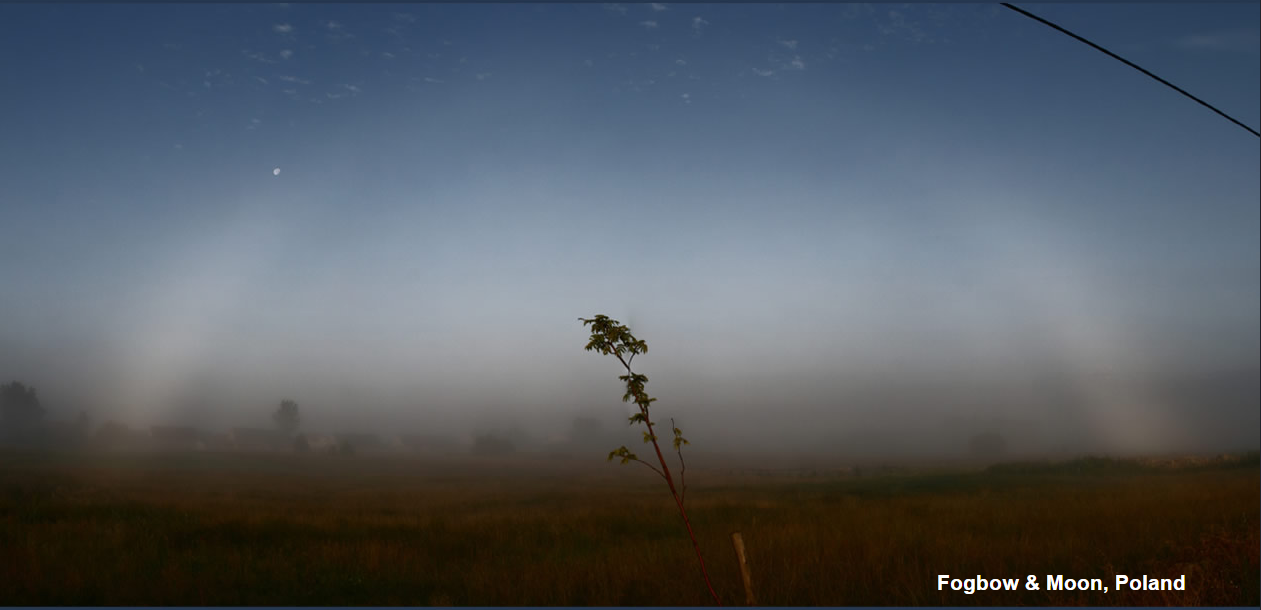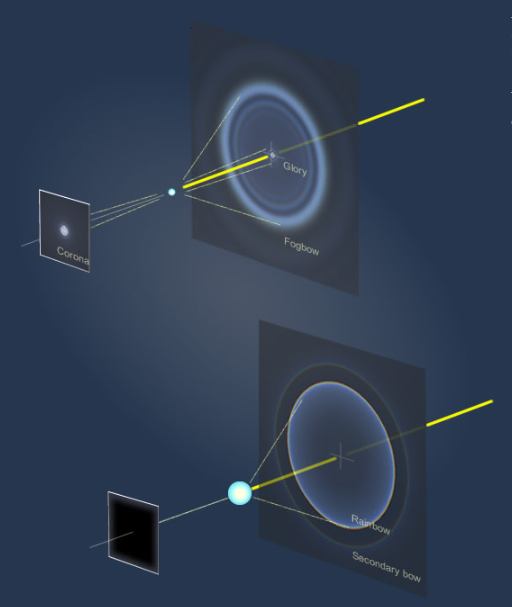OPOD - Fogbow & Moon, Poland
OPOD - Fogbow & Moon, Poland: A Mystical Atmospheric Phenomenon
Have you ever witnessed a breathtaking display of atmospheric optics? In the early morning hours, Tomasz Adam of Staszów, Poland captured a stunning image of a fogbow gracefully adorning the sky. The sheer size of this ethereal spectacle becomes apparent when you notice the tiny waning moon perched at the upper left corner of the photograph. Let's delve into the enchanting world of fogbows and explore the fascinating science behind this captivating phenomenon.
Unveiling the Secrets of Fogbows
Unlike traditional rainbows formed by raindrops, fogbows emerge when light interacts with minuscule fog droplets. These droplets are so small that they reveal the wave nature of light as it scatters and diffracts in all directions, creating a mesmerizing and intricate ringed pattern across the sky. The finite size of the sun and variations in droplet size blur out the closely spaced oscillations, while background skylight further obscures the scene. Nevertheless, certain elements manage to defy these obstacles and stand out amidst the misty ambiance.
The Enigmatic Fogbow Components
Within the fogbow lies a dark space, followed by a faint and broad supernumerary bow. Supernumeraries are additional bands of light that appear on the inner edge of rainbows and fogbows. Although raindrops are significantly larger than fog droplets, these faint supernumeraries within fogbows provide us with subtle hints of their wave-like behavior.
Let's take a closer look at the specific components that comprise a fogbow:
-
Colored Corona: Encircling the sun, a vibrant corona manifests itself as a direct consequence of diffraction and scattering phenomena. This colorful halo adds a touch of wonder to the fogbow spectacle.
-
Ringed Glory: Opposite to the sun, we find a captivating ringed glory. This circular feature arises from light waves interacting with fog droplets and undergoing diffraction and interference. Its alluring appearance is sure to captivate any observer.
-
The Ghostly Fogbow: Finally, we come to the pièce de résistance—the fogbow itself. Unlike the distinct and vibrant hues of a rainbow formed by raindrops, the fogbow possesses a more ethereal and ghostly quality. Its large size and pale coloration make it a truly enchanting sight.
The Distinction Between Fogbows and Rainbows
One might wonder, what sets fogbows apart from their more well-known counterparts, rainbows? The answer lies in the size of the water droplets that give birth to these optical phenomena. While fog droplets are tiny, ranging from 10 to 1000 times smaller than raindrops, rainbows emerge from the interaction of sunlight with larger rain droplets. As a result, the diffraction effects observed in fogbows are relatively small compared to the more pronounced effects seen in rainbows.
Here are a few notable distinctions between fogbows and rainbows:
- Diffuse vs. Distinct: Fogbows exhibit a diffuse appearance, lacking the vibrant colors and sharp edges of rainbows.
- Supernumeraries: Fogbows often display faint supernumeraries, providing subtle hints of wave-like behavior.
- Size Matters: The larger size of raindrops contributes to the formation of more well-defined rainbows, while fog droplets produce larger, ghostly fogbows.
A Glimpse Into the Science of Fogbows
The science behind fogbows lies in the intricate interplay between light waves and tiny fog droplets. As light encounters these minuscule droplets, it undergoes scattering, diffraction, and interference, leading to the formation of the distinctive fogbow pattern. The wave nature of light becomes apparent as it oscillates and interacts with the droplets, resulting in the ethereal beauty we witness in the sky.
The complex phenomenon of fogbows can be attributed to several factors:
- Wave Nature of Light: Light waves exhibit diffraction and interference when interacting with fog droplets, giving rise to the intricate patterns seen in fogbows.
- Size of Droplets: The small size of fog droplets allows light to reveal its wave-like behavior more prominently, leading to the diffused appearance of fogbows.
- Background Skylight: The presence of ambient skylight contributes to the obscuring of certain details within fogbows, blurring out closely spaced oscillations.
Conclusion
Witnessing a fogbow gracefully adorning the sky is an awe-inspiring experience. The interplay between light waves and tiny fog droplets creates a mystical atmosphere, with ethereal components such as the colored corona, ringed glory, and the ghostly fogbow itself. While rainbows formed by raindrops exhibit distinct hues and well-defined features, fogbows possess a more diffuse and ghostly appearance. Understanding the science behind these atmospheric phenomena adds a new layer of appreciation for the wonders of our natural world. So keep your eyes peeled during those misty mornings—you might just catch a glimpse of this captivating display in the heavens above.

Fogbow & Moon, Poland
Tomasz Adam of Staszów, Poland imaged this early morning fogbow. Its huge dimensions are evidenced by the diminutive waning moon at upper left.
Inside the bow there is a dark space and then a faint and broad supernumerary bow.
© Tomasz Adam , shown with permission.

Fog droplets are sufficiently small that light interacting with them reveals its wave nature. Light is no longer simply refracted or reflected as when a rainbow is formed. Instead, light waves are scattered, diffracted, in all directions to produce a wildly oscillating and complex ringed pattern around the sky.
The finite size of the sun and variations in droplet size blur out the very closely spaced oscillations and background skylight conspires to obscures more. But the brightest survive; a coloured corona around the sun, a ringed glory directly opposite and a large and ghostly fogbow.
Raindrops are 10-1000X larger than fog droplets and their diffraction effects are consequently small. The corona and glory shrink to insignificance and instead of a diffuse fogbow we see a rainbow. Yet the latter retains echoes of waves in its supernumeraries.
Note: this article has been automatically converted from the old site and may not appear as intended. You can find the original article here.
Reference Atmospheric Optics
If you use any of the definitions, information, or data presented on Atmospheric Optics, please copy the link or reference below to properly credit us as the reference source. Thank you!
-
<a href="https://atoptics.co.uk/blog/opod-fogbow-moon-poland/">OPOD - Fogbow & Moon, Poland</a>
-
"OPOD - Fogbow & Moon, Poland". Atmospheric Optics. Accessed on November 26, 2024. https://atoptics.co.uk/blog/opod-fogbow-moon-poland/.
-
"OPOD - Fogbow & Moon, Poland". Atmospheric Optics, https://atoptics.co.uk/blog/opod-fogbow-moon-poland/. Accessed 26 November, 2024
-
OPOD - Fogbow & Moon, Poland. Atmospheric Optics. Retrieved from https://atoptics.co.uk/blog/opod-fogbow-moon-poland/.